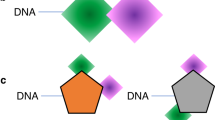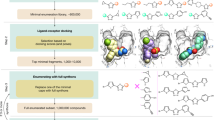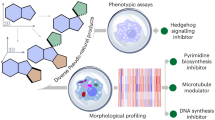Abstract
A prerequisite for successful screening campaigns in drug discovery or chemical genetics is the availability of structurally and thus functionally diverse compound libraries. Diversity-oriented synthesis (DOS) provides strategies for the generation of such libraries, of which the build/couple/pair (B/C/P) algorithm is the most frequently used. We have developed an advanced B/C/P strategy that incorporates multidimensional coupling. In this approach, structural diversity is not only defined by the nature of the building blocks employed, but also by the linking motif installed during the coupling reaction. We applied this step-efficient approach in a DOS of a library that consisted of 73 macrocyclic compounds based around 59 discrete scaffolds. The macrocycles prepared cover a broad range of different molecular shapes, as illustrated by principal moment-of-inertia analysis. This demonstrates the capability of the advanced B/C/P strategy using multidimensional coupling for the preparation of structurally diverse compound collections.
This is a preview of subscription content, access via your institution
Access options
Subscribe to this journal
Receive 12 print issues and online access
$259.00 per year
only $21.58 per issue
Buy this article
- Purchase on Springer Link
- Instant access to full article PDF
Prices may be subject to local taxes which are calculated during checkout






Similar content being viewed by others
References
Spring, D. R. Diversity-oriented synthesis; a challenge for synthetic chemists. Org. Biomol. Chem. 1, 3867–3870 (2003).
Burke, M. D. & Schreiber, S. L. A planning strategy for diversity-oriented synthesis. Angew. Chem. Int. Ed. 43, 46–58 (2004).
Galloway, W. R. J. D., Isidro-Llobet, A. & Spring, D. R. Diversity-oriented synthesis as a tool for the discovery of novel biologically active small molecules. Nature Commun. 1, 80 (2010).
Macarron, R. et al. Impact of high-throughput screening in biomedical research. Nature Rev. Drug Discov. 10, 188–195 (2011).
Frearson, J. A. & Collie, I. T. HTS and hit finding in academia – from chemical genomics to drug discovery. Drug Discov. Today 14, 1150–1158 (2009).
Dandapani, S. & Marcaurelle, L. A. Grand challenge commentary: accessing new chemical space for ‘undruggable' targets. Nature Chem. Biol. 6, 861–863 (2010).
O'Connor, C. J., Laraia, L. & Spring, D. R. Chemical genetics. Chem. Soc. Rev. 40, 4332–4345 (2011).
O'Connor, C. J., Beckmann, H. S. G. & Spring, D. R. Diversity-oriented synthesis: producing chemical tools for dissecting biology. Chem. Soc. Rev. 41, 4444–4456 (2012).
Tan, D. S. Diversity-oriented synthesis: exploring the intersections between chemistry and biology. Nature Chem. Biol. 1, 74–84 (2005).
Oh, S. & Park, S. B. A design strategy for drug-like polyheterocycles with privileged substructures for discovery of specific small-molecule modulators. Chem. Commun. 47, 12754–12761 (2011).
Wetzel, S., Bon, R. S., Kumar, K. & Waldmann, H. Biology-oriented synthesis. Angew. Chem. Int. Ed. 50, 10800–10826 (2011).
Brown, L. E. et al. Discovery of new antimalarial chemotypes through chemical methodology and library development. Proc. Natl Acad. Sci. USA 108, 6775–6780 (2011).
Burke, M. D., Berger, E. M. & Schreiber, S. L. Generating diverse skeletons of small molecules combinatorially. Science 302, 613–618 (2003).
Clemons, P. A. et al. Small molecules of different origins have distinct distributions of structural complexity that correlate with protein-binding profiles. Proc. Natl Acad. Sci. USA 107, 18787–18792 (2010).
Huigens R. W. III, et al. A ring-distortion strategy to construct stereochemically complex and structurally diverse compounds from natural products. Nature Chem. 5, 195–202 (2013).
Morton, D., Leach, S., Cordier, C., Warriner, S. & Nelson, A. Synthesis of natural-product-like molecules with over eighty distinct scaffolds. Angew. Chem. Int. Ed. 48, 104–109 (2009).
Thomas, G. L. et al. Anti-MRSA agent discovery using diversity-oriented synthesis. Angew. Chem. Int. Ed. 47, 2808–2812 (2008).
Dow, M., Fisher, M., James, T., Marchetti, F. & Nelson, A. Towards the systematic exploration of chemical space. Org. Biomol. Chem. 10, 17–28 (2012).
Sauer, W. H. B. & Schwarz, M. K. Molecular shape diversity of combinatorial libraries: a prerequisite for broad bioactivity. J. Chem. Inf. Comput. Sci. 43, 987–1003 (2003).
Nielsen, T. E. & Schreiber, S. L. Towards the optimal screening collection: a synthesis strategy. Angew. Chem. Int. Ed. 47, 48–56 (2008).
Driggers, E. M., Hale, S. P., Lee, J. & Terrett, N. K. The exploration of macrocycles for drug discovery – an underexploited structural class. Nature Rev. Drug Discov. 7, 608–624 (2008).
Marsault, E. & Peterson, M. L. Macrocycles are great cycles: applications, opportunities, and challenges of synthetic macrocycles in drug discovery. J. Med. Chem. 54, 1961–2004 (2011).
Cummings, M. D. et al. Structure-based macrocyclization yields hepatitis C virus NS5B inhibitors with improved binding affinities and pharmacokinetic properties. Angew. Chem. Int. Ed. 51, 4637–4640 (2012).
Terrett, N. K. Methods for the synthesis of macrocycle libraries for drug discovery. Drug Discov. Today Technol. 7, e97–e104 (2010).
White, C. J. & Yudin, A. K. Contemporary strategies for peptide macrocyclization. Nature Chem. 3, 509–524 (2011).
Yoo, B., Shin, S. B. Y., Huang, M. L. & Kirshenbaum, K. Peptoid macrocycles: making the rounds with peptidomimetic oligomers. Chem. Eur. J. 16, 5528–5537 (2010).
Madsen, C. M. & Clausen, M. H. Biologically active macrocyclic compounds – from natural products to diversity-oriented synthesis. Eur. J. Org. Chem. 2011, 3107–3115 (2011).
Bauer, R. A., Wenderski, T. A. & Tan, D. S. Biomimetic diversity-oriented synthesis of benzannulated medium rings via ring expansion. Nature Chem. Biol. 9, 21–29 (2013).
Kopp, F., Stratton, C. F., Akella, L. B. & Tan, D. S. A diversity-oriented synthesis approach to macrocycles via oxidative ring expansion. Nature Chem. Biol. 8, 358–365 (2012).
Comer, E. et al. Fragment-based domain shuffling approach for the synthesis of pyran-based macrocycles. Proc. Natl Acad. Sci. USA 108, 6751–6756 (2011).
O'Connell, K. M. G. et al. A two-directional strategy for the diversity-oriented synthesis of macrocyclic scaffolds. Org. Biomol. Chem. 10, 7545–7551 (2012).
Marcaurelle, L. A. et al. An aldol-based build/couple/pair strategy for the synthesis of medium- and large-sized rings: discovery of macrocyclic histone deacetylase inhibitors. J. Am. Chem. Soc. 132, 16962–16976 (2010).
Isidro-Llobet, A. et al. Diversity-oriented synthesis of macrocyclic peptidomimetics. Proc. Natl Acad. Sci. USA 108, 6793–6798 (2011).
Palacios, F., Alonso, C., Aparicio, D., Rubiales, G. & de los Santos, J. M. The aza-Wittig reaction: an efficient tool for the construction of carbon–nitrogen double bonds. Tetrahedron 63, 523–575 (2007).
Rostovtsev, V. V., Green, L. G., Fokin, V. V. & Sharpless, K. B. A stepwise Huisgen cycloaddition process: copper(I)-catalyzed regioselective ‘ligation’ of azides and terminal alkynes. Angew. Chem. Int. Ed. 41, 2596–2599 (2002).
Tornøe, C. W., Christensen, C. & Meldal, M. Peptidotriazoles on solid phase: [1,2,3]-triazoles by regiospecific copper(I)-catalysed 1,3-dipolar cycloadditions of terminal alkynes to azides. J. Org. Chem. 67, 3057–3064 (2002).
Zhang, L. et al. Ruthenium-catalysed cycloaddition of alkynes and organic azides. J. Am. Chem. Soc. 127, 15998–15999 (2005).
Kelly, A. R. et al. Accessing skeletal diversity using catalyst control: formation of n and n + 1 macrocyclic triazole rings. Org. Lett. 11, 2257–2260 (2009).
Hansen, E. C. & Lee, D. Ring closing enyne metathesis: control over mode selectivity and stereoselectivity. J. Am. Chem. Soc. 126, 15074–15080 (2004).
Zhang, W. Fluorous linker-facilitated chemical synthesis. Chem. Rev. 109, 749–795 (2009).
Zhang, W. & Curran, D. P. Synthetic applications of fluorous solid-phase extraction (F-SPE). Tetrahedron 62, 11837–11865 (2006).
Ménand, M. & Jabin, I. Synthesis of the first calix[6]crypturea via a versatile tris-azide precursor. Org. Lett. 11, 673–676 (2009).
Yagodkin, A., Löschcke, K., Weisell, J. & Azhayev, A. Straightforward carbamoylation of nucleophilic compounds employing organic azides, phosphines, and aqueous trialkylammonium hydrogen carbonate. Tetrahedron 66, 2210–2221 (2010).
Zhang, L-F., Chen, L., Lee, T-C. & Ng, S-C. A facile route into 6A-mono-ω-alkenylcarbamido-6A-deoxy-perfunctionalised cyclodextrin: key intermediate for further reactive functionalisations. Tetrahedron: Asymmetry 10, 4107–4113 (1999).
Sallas, F. et al. Synthesis and study of new β-cyclodextrin ‘dimers’ having a metal coordination center and carboxamide or urea linkers. Helv. Chim. Acta 81, 632–645 (1998).
Loncaric, C., Manabe, K. & Kobayashi, S. AgOTf-catalyzed aza-Diels–Alder reactions of Danishefsky's diene with imines in water. Adv. Synth. Catal. 345, 475–477 (2003).
Bauer, R. A., Wurst, J. M. & Tan, D. S. Expanding the range of ‘druggable' targets with natural product-based libraries: an academic perspective. Curr. Opin. Chem. Biol. 14, 308–314 (2010).
Acknowledgements
This work was supported by the European Union, Engineering and Physical Sciences Research Council, Biotechnology and Biological Sciences Research Council, Medical Research Council, Frances and Augustus Newman Foundation, Wellcome Trust and Isaac Newton Trust. H.S.G.B. acknowledges a fellowship within the Postdoctoral Programme of the German Academic Exchange Service. F.N. thanks the Gates Cambridge Trust and acknowledges a Krishnan-Ang Studentship. Y.S.T. thanks the Agency for Science, Technology and Research and D.W. thanks the German Research Foundation for a postdoctoral fellowship (WI 4198/1-1).
Author information
Authors and Affiliations
Contributions
H.S.G.B., D.W. and D.R.S. conceived and supervised the project. H.S.G.B., F.N., C.E.H., H.J. and D.W. planned, performed and evaluated the experiments. Y.S.T. performed the molecular informatics studies. H.S.G.B., F.N., D.W. and D.R.S. wrote the paper. All authors discussed the results and commented on the manuscript.
Corresponding author
Ethics declarations
Competing interests
The authors declare no competing financial interests.
Supplementary information
Supplementary information
Supplementary information (PDF 15736 kb)
Supplementary information
Supplementary information (CIF 21 kb)
Rights and permissions
About this article
Cite this article
Beckmann, H., Nie, F., Hagerman, C. et al. A strategy for the diversity-oriented synthesis of macrocyclic scaffolds using multidimensional coupling. Nature Chem 5, 861–867 (2013). https://doi.org/10.1038/nchem.1729
Received:
Accepted:
Published:
Issue Date:
DOI: https://doi.org/10.1038/nchem.1729
This article is cited by
-
Diversity-oriented synthesis encoded by deoxyoligonucleotides
Nature Communications (2023)
-
Comprehensive exploration of chemical space using trisubstituted carboranes
Scientific Reports (2021)
-
Marine furanocembranoids-inspired macrocycles enabled by Pd-catalyzed unactivated C(sp3)-H olefination mediated by donor/donor carbenes
Nature Communications (2021)
-
Synthesis and evaluation of mycophenolic acid derivatives as potential anti-Toxoplasma gondii agents
Medicinal Chemistry Research (2021)
-
Conformational analysis of macrocycles: comparing general and specialized methods
Journal of Computer-Aided Molecular Design (2020)



